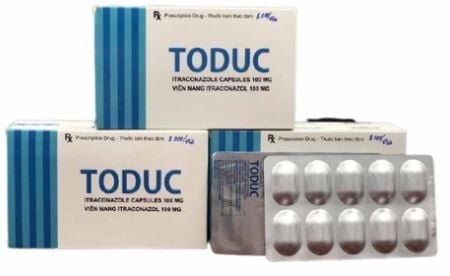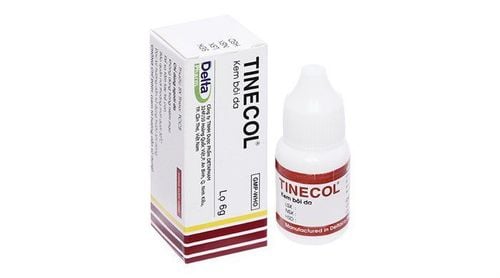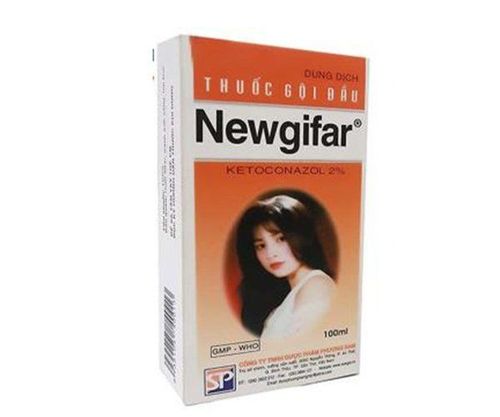This is an automatically translated article.
Benzosali belongs to the group of drugs for the treatment of dermatological diseases. The drug is indicated for the treatment of common cases of dermatitis. Let's learn Benzosali drug about how to use and note when using the drug in the article below.1. What is Benzosali?
Benzosali contains ingredients Benzoic acid content of 0.6g, Salicylic acid content of 0.3g and other excipients just enough for 1 tube of 10g provided by the manufacturer. The drug is prepared in the form of a topical ointment, packed in a box of 1 tube of 10g. The effect of the active ingredient Benzoic acid is to work with Salicylic acid in skin creams to reduce inflammation or irritation caused by the unwanted effects of Salicylic acid.The effect of the active ingredient Salicylic acid is to soften, destroy and peel the stratum corneum on the skin. In addition, this active ingredient also has a mild antiseptic effect on the damaged skin.
2. What are the effects of Benzosali?
Benzosali is indicated for the treatment of the following cases:Treatment of inflammatory skin conditions caused by fungal diseases such as tinea versicolor, hair fungus and interstitial fungus. Treatment of localized hyperkeratosis on the palms of the hands and soles of the feet. Treatment of psoriasis, which has scaling on areas of the skin such as the scalp or in other areas of the skin with moderate or higher. Helps relieve symptoms caused by seborrheic dermatitis. In addition, Benzosali is contraindicated in the following cases:
Patients are allergic to the active ingredients Benzoic acid, Salicylic acid or any antibiotic of the Macrolide group or other excipients in the composition of the drug. Pregnant women. Do not use the drug on the mucous membranes or use the drug on a large area of the skin.
3. Dosage and how to use Benzosali
The drug is prepared in the form of skin ointment, so patients use the drug by applying it directly to the skin of the affected area to be treated. Clean the area to be applied the medicine clean before applying the medicine. Take an appropriate amount of medicine for the area of skin to be treated. Gently rub the medicine to help it fully absorb into the upper skin. Wash hands after use to avoid superinfection or bacterial transmission to healthy skin. The drug should be applied 1-2 times per day to achieve the desired effect. Can be used simultaneously with topical alcohol drugs such as ASA or BSI to improve the treatment effect. Note: This is the reference dose provided by the manufacturer. The treating doctor depends on the medical condition and health of each patient to prescribe the appropriate dose.4. Side effects of Benzosali
Doctors always consider between the benefits that Benzosali brings to the patient and the possible risk of side effects to prescribe the appropriate medication.
Some possible side effects when using the drug are recorded including:
Mild skin irritation, stinging sensation when applying the medicine, skin corrosion, dry skin, peeling of the outer layer of skin. In case of large-scale drug use for a long time, there may be a risk of salicylate poisoning with symptoms such as:
Confusion, headache, dizziness, rapid breathing, heaviness in the head, ringing in the ears. Note: In case the patient occurs side effects that are not mentioned in the instruction sheet. Inform your doctor or medical officer immediately if you suspect any side effects of Benzosali.
5. Benzosali drug interactions
During the use of Benzosali, drug interactions may occur when Benzosali is used in combination with other drugs or products to support skin use.The above interactions may be incomplete, so if during the use of Benzosali, the user suspects that interactions with food, drugs or other functional foods, please stop using this medicine and seek medical attention immediately.
To avoid interactions, before being prescribed Benzosali, patients should inform their doctors about all the drugs they are using, including functional foods. The doctor will base on that to prescribe the appropriate Benzosali.
6. Notes when using Benzosali
Some notes when the patient uses Benzosali as follows:Be careful with the skin where the medicine is applied, if the medicine comes into contact with the skin of another person, there may be irritating reactions on the healthy skin. If the drug is indicated for treatment in the closed skin area - covered by clothing, the patient needs to inform the doctor to be prescribed the appropriate dose and number of times to take the drug daily. Be careful not to get the medicine in your eyes. In case of accidental contact with eyes, rinse immediately under clean running water. If there is severe eye irritation, the patient should be taken to a medical facility immediately for timely first aid. Patients should take the medicine at the right dose, in the full dose according to the instructions on the instruction sheet or follow the treatment regimen prescribed by the doctor or pharmacist to ensure optimal treatment effect. Benzosali may increase your skin's sensitivity to sunlight. Therefore, during the time of using the drug, the patient should cover the treatment area when moving and doing outdoor activities. In case the patient has used the drug continuously for 7 days but does not see clinical symptoms improve or even worsen. The patient should stop taking the drug and notify the treating doctor for advice. Patients need to carefully check the expiry date of the drug before using it to ensure safety, to avoid endangering the patient's life because expired ingredients of the drug can cause toxicity. Pregnant women: When using Benzosali, there may be potential risks affecting the fetus such as miscarriage, malformation,... Therefore, this drug should not be used during pregnancy, unless when absolutely necessary for the therapeutic benefit of the mother and prescribed by a physician. Lactation: Although the drug is known to be excreted in human milk, its effect on a nursing infant has not been adequately studied. Therefore, in order to avoid potential risks that may directly affect the nursing infant, the drug should not be used unless prescribed by the treating physician. The patient can stop breastfeeding if the drug must be taken for the treatment of the mother's illness.













